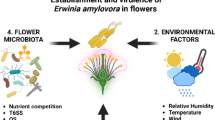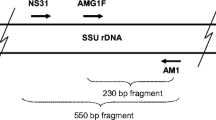Abstract
Partly buried stem segments and stumps of thinned trees were treated with basidiospores at varying densities to test the likelihood that spread of Armillaria novae-zelandiae into Pinus radiata plantations in New Zealand is occurring through the colonisation of woody material by airborne spores. Colonisation of stem segments was confirmed at densities ranging between 20 million and 5 spores/cm2 of exposed cut surface. Degree of colonisation was not influenced by the presence or absence of a protecting wood disc placed over the surface after treatment. In one study, the incidence of colonisation was significantly greater in segments taken from trees felled 3 weeks rather than 3 months earlier, but colonisation was still effective in the older material. The colonisation of freshly cut pine stumps was also demonstrated at densities exceeding 13 million spores/cm2 surface, but stumps may be less receptive to spore colonisation than stem segments. Tiny mycelial ribbons present beneath the bark of stem segments but not stumps in all studies were found to belong to Rosellinia thelena, a species newly recorded in New Zealand.
Similar content being viewed by others
References
Boesewinkel HJ (1977) New plant disease records in New Zealand: records in the period 1969–76. New Zealand Journal of Agricultural Research 20, 583–589.
Butcher JA (1967) Degrade by fungi of Pinus radiata posts during seasoning. New Zealand Forest Service Technical Paper No. 52. R.E. Owen, Government Printer, Wellington, New Zealand, 23 pp.
Butcher JA (1968) The ecology of fungi infecting untreated sapwood of Pinus radiata. Canadian Journal of Botany 46, 1577–1589.
Dingley JM (1969) Records of plant diseases in New Zealand. New Zealand Department of Scientific and Industrial Research Bulletin No. 192. A.R. Shearer, Government Printer, Wellington, New Zealand, 298 pp.
Dodd SL, Shah FH, Hood IA (2006) Molecular tools to determine the mode of spread of the root pathogen Armillaria in commercial pine forests. (Poster abstract AP-493) In ‘Proceedings of the joint meeting of the American Phytopathological Society, Canadian Phytopathological Society, and the Mycological Society of America, 29 July-2 August, 2006, Qu’ebec City, Qu’ebec, Canada’. (CD-ROM) (American Phytopathological Society: St Paul, MN)
Gadgil PD (2005) ‘Fungi on trees and shrubs in New Zealand. The Fungi of New Zealand. 4. Landcare Research New Zealand. Fungal Diversity Research Series 16.’ (Fungal Diversity Press: Hong Kong) 437 pp.
Gilmour JW (1954) Armillaria mellea (Vahl) Sacc. in New Zealand forests Part 1. In ‘Stands of Pinus radiata D. Don in Kaingaroa State Forest. Forest Research Notes 1(9)’. pp. 1–40. (Forest Research Institute, New Zealand Forest Service: Wellington, New Zealand)
Gilmour JW (1966) The pathology of forest trees in New Zealand. The fungal, bacterial, and algal pathogens. New Zealand Forest Service Technical Paper 48. New Zealand Forest Research Institute. New Zealand Forest Service, Wellington, New Zealand, 82 pp.
Hood IA, Gardner JF (2005) Colonisation of Pinus radiata thinning stumps by Armillaria and other basidiomycetes following treatment with Armillaria basidiospores. In ‘Root and butt rots of forest trees. The 11th international conference on root and butt rots, Pozna’n — Bialowieza (Poland), August 16-22, 2004. IUFRO Working Party 7.02.01’. (Eds M Ma’nka, P Lakomy) pp. 196–208. (The August Cieszkowski Agricultural University: Pozna’n, Poland)
Hood IA, Sandberg CJ (1987) Occurrence of Armillaria rhizomorph populations in the soil beneath indigenous forests in the Bay of Plenty New Zealand. New Zealand Journal of Forestry Science 17, 83–99.
Hood IA, Sandberg CJ (1993) Armillaria populations in a Pinus radiata plantation on a former indigenous rainforest site. New Zealand Journal of Forestry Science 23, 62–77.
Hood IA, Sandberg CJ, Kimberley MO (1989) A decay study in windthrown indigenous trees. New Zealand Journal of Botany 27, 281–297.
Hood IA, Horner IJ, Gardner JF, Sandberg CJ (2002a) Armillaria root disease of Pinus radiata in New Zealand. 1. Basidiospore dispersal. New Zealand Journal of Forestry Science 32, 94–102.
Hood IA, Kimberley MO, Gardner JF, Sandberg CJ (2002b) Armillaria root disease of Pinus radiata in New Zealand. 3. Influence of thinning and pruning. New Zealand Journal of Forestry Science 32, 116–132.
Kluge E (1967) Rosellinia thelena Rabh. als Parasit an Eichensämlingen. Archiv für Pflanzenschutz 3, 185–192.
Merrill W (1970) Spore germination and host penetration by heartrotting hymenomycetes. Annual Review of Phytopathology 8, 281–300. doi: 10.1146/annurev.py.08.090170.001433
Nakasone KK (1990) Cultural studies and identification of wood-inhabiting Corticiaceae and selected Hymenomycetes from North America. Mycological Memoirs 15, 1–412.
Nobles MK (1965) Identification of cultures of wood-inhabiting Hymenomycetes. Canadian Journal of Botany 43, 1097–1139.
Pennycook SR (1989) ‘Plant diseases recorded in New Zealand. Vol. 2. Fungal plant diseases recorded in New Zealand.’ (Plant Diseases Division, Department of Scientific and Industrial Research: Auckland, New Zealand) 502 pp.
Petrini LE (1993) Rosellinia species of the temperate zones. Sydowia 44, 169–281.
Petrini LE (2003) Rosellinia and related genera in New Zealand. New Zealand Journal of Botany 41, 71–138.
Power MWP, Ramsfield TD, Dodd SL, Hood IA (2007) Detection of Armillaria basidiospore dispersal using molecular techniques (poster abstract). New Zealand Plant Protection 60, 306.
Rishbeth J (1970) The role of basidiospores in stump infection by Armillaria mellea. In ‘Root diseases and soil-borne pathogens. Proceedings of the 2nd international symposium on factors determining the behaviour of plant pathogens in soil, July 1968, Imperial College, London’. (Eds TA Toussoun, RV Bega, PE Nelson) pp. 141–146. (University of California Press: Berkeley, CA)
Shaw CG III (1981) Basidiospores of Armillaria mellea survive an Alaskan winter on tree bark. Plant Disease 65, 972–974.
Stalpers JA (1978) Identification of wood-inhabiting Aphyllophorales in pure culture. Centraalbureau voor Schimmelcultures. Studies in Mycology 16, 1–248.
Author information
Authors and Affiliations
Corresponding author
Rights and permissions
About this article
Cite this article
Hood, I.A., Petrini, L.E. & Gardner, J.F. Colonisation of woody material in Pinus radiata plantations by Armillaria novae-zelandiae basidiospores. Australasian Plant Pathology 37, 347–352 (2008). https://doi.org/10.1071/AP08030
Received:
Accepted:
Issue Date:
DOI: https://doi.org/10.1071/AP08030




